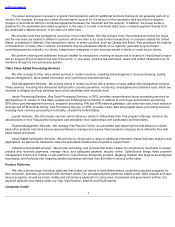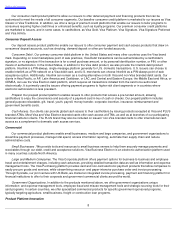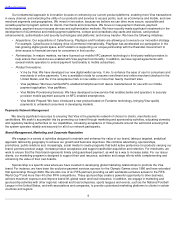Visa 2012 Annual Report Download - page 19
Download and view the complete annual report
Please find page 19 of the 2012 Visa annual report below. You can navigate through the pages in the report by either clicking on the pages listed below, or by using the keyword search tool below to find specific information within the annual report.
Table of Contents
based on lowest cost or other factors. Other clients and merchants are likely to take similar actions in the future.
The Dodd-Frank Act created a new independent Consumer Financial Protection Bureau, with responsibility for most federal
consumer protection laws in the area of financial services and new authority with respect to consumer protection issues, including
those pertaining to us to some extent. Although the bureau's future actions may benefit consumers, these actions may also make
payment card transactions less attractive to card issuers, consumers and merchants by further regulating disclosures, payment
card practices, fees, routing and other matters with respect to credit, debit, and prepaid.
Some elements of the Dodd-Frank Act lack definition and create the potential for networks to pursue different strategies
subject to their interpretation of the regulation. Our interpretation may result in our pursuit of strategies less effective than those of
our competitors.
Overall, the regulations and developments arising from the Dodd-Frank Act could continue to have a material, adverse effect
on our financial condition, revenues, results of operations, prospects for future growth and overall business.
New regulations or legal action in one jurisdiction or of one product segment may lead to new regulations in other
jurisdictions or of other products
.
Regulators around the world increasingly note each other's approaches to the regulation of the payments industry.
Consequently, a development in any one country, state or region may influence regulatory approaches in another. The Dodd-Frank
Act is one development with such potential. Similarly, new laws and regulations in a country, state or region involving one product
segment may cause lawmakers there to extend the regulations to another product. For example, regulations like those affecting
debit payments could eventually spread to regulate credit.
As a result, the risks created by any one new law or regulation are magnified by the potential they have to be replicated,
affecting our business in another place or involving another product segment. These include matters like interchange
reimbursement fees, network exclusivity, preferred routing, dynamic currency conversion, point of sale transaction rules and
practices, and operating regulations. Conversely, if widely varying regulations come into existence worldwide, we may have
difficulty adjusting our products, services and fees, and other important aspects of our business. Either of these eventualities could
materially and adversely affect our business, financial condition and results of operations.
Government actions may prevent us from competing effectively against providers of domestic payments services in
certain countries, materially and adversely affecting our ability to maintain or increase our revenues .
Governments in some countries provide resources or protection to select domestic payment card networks, brands and
processing providers. These governments may take this action in order to support these providers. They may also take this action
to keep us from entering these countries, to force us to leave, or to restrict substantially our activities there. For example, the
government of China continues to maintain regulations that substantially favor China Union Pay, the only retail payments network
currently operating in the Chinese domestic market. Additionally, governments in some countries may consider regulatory
requirements that mandate processing of domestic payments entirely in that country. This would prevent us from utilizing our global
processing capabilities for our clients. Our efforts to effect change in these countries may not succeed. This could adversely affect
our ability to maintain or increase our revenues and extend our global brands.
Regulation in the areas of consumer privacy and data use and security could decrease the number of payment cards
issued, our payments volume and our revenues .
Recently, privacy, data use and security have received heightened legislative and regulatory focus in the United States and
elsewhere. For example, in many jurisdictions consumers must be notified in the event of a data breach. These measures may
increase our and our clients' costs. They may also decrease the number of Visa-branded cards our clients issue. This would
materially and adversely affect our profitability. In addition, our failure or the failure of our clients to comply with these laws and
regulations could result in fines, sanctions, litigation and damage to our global reputation and our brands.
Increased global regulatory focus on the payments industry may result in costly new compliance burdens on our clients
and on us, leading to increased costs and decreased payments volume and revenues .
17
























